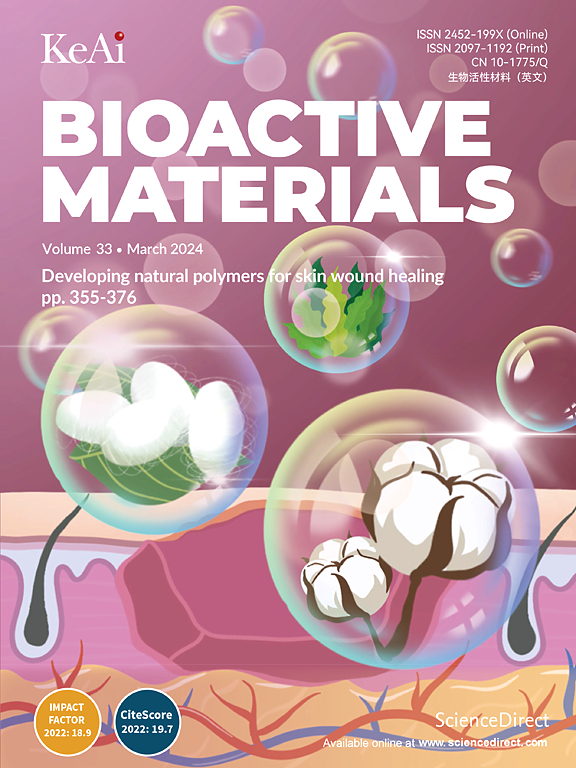Cryogenic, but not hypothermic, preservation disrupts the extracellular matrix of cell sheets
IF 18
1区 医学
Q1 ENGINEERING, BIOMEDICAL
引用次数: 0
Abstract
Cell sheet (CS)-based approaches hold significant potential for tissue regeneration, relying on the extracellular matrix (ECM) for success. Like in native tissues, the ECM provides structural and biochemical support for cellular homeostasis and function. Effective preservation strategies that maintain ECM integrity are critical to enhance the therapeutic potential of CS-based approaches. While cryogenic and hypothermic preservation methods offer potential solutions, their impact on CS ECM structure is not fully understood. Therefore, a comprehensive analysis of the ECM of hASCs CS following cryogenic and hypothermic preservation for 3 and 7 days, was conducted. Although proteomic analysis indicated that cryopreservation had no significant effect on the overall composition of the ECM, it induced significant ECM structural alterations, particularly disrupting collagen organization, which was not observed following hypothermic preservation. These structural changes were accompanied by alterations in mechanical properties, including a reduction in elastic modulus. In contrast, hypothermic preservation maintained ECM integrity and mechanical properties similar to the control. The notable ECM structural changes following cryogenic preservation can potentially impact cellular behavior, including adhesion, proliferation, and differentiation, thereby affecting the efficacy of CS therapies in vivo. This suggests that hypothermia may offer a promising alternative to cryopreservation for preserving CS integrity and functionality.

低温保存,而不是低温保存,会破坏细胞片的细胞外基质。
基于细胞片(CS)的方法具有重要的组织再生潜力,依赖于细胞外基质(ECM)的成功。与天然组织一样,ECM为细胞稳态和功能提供结构和生化支持。维持ECM完整性的有效保存策略对于增强基于cs的入路的治疗潜力至关重要。虽然低温和低温保存方法提供了潜在的解决方案,但它们对CS ECM结构的影响尚不完全清楚。因此,我们对hASCs CS在低温和低温保存3天和7天后的ECM进行了综合分析。尽管蛋白质组学分析表明,低温保存对ECM的整体组成没有显著影响,但它引起了ECM结构的显著改变,特别是破坏了胶原组织,而低温保存没有观察到这一点。这些结构变化伴随着机械性能的改变,包括弹性模量的降低。相比之下,低温保存保持了ECM的完整性和与对照组相似的机械性能。低温保存后显著的ECM结构变化可能潜在地影响细胞行为,包括粘附、增殖和分化,从而影响CS治疗在体内的疗效。这表明,低温可能是一种有前途的替代冷冻保存,以保持CS的完整性和功能。
本文章由计算机程序翻译,如有差异,请以英文原文为准。
求助全文
约1分钟内获得全文
求助全文
来源期刊

Bioactive Materials
Biochemistry, Genetics and Molecular Biology-Biotechnology
CiteScore
28.00
自引率
6.30%
发文量
436
审稿时长
20 days
期刊介绍:
Bioactive Materials is a peer-reviewed research publication that focuses on advancements in bioactive materials. The journal accepts research papers, reviews, and rapid communications in the field of next-generation biomaterials that interact with cells, tissues, and organs in various living organisms.
The primary goal of Bioactive Materials is to promote the science and engineering of biomaterials that exhibit adaptiveness to the biological environment. These materials are specifically designed to stimulate or direct appropriate cell and tissue responses or regulate interactions with microorganisms.
The journal covers a wide range of bioactive materials, including those that are engineered or designed in terms of their physical form (e.g. particulate, fiber), topology (e.g. porosity, surface roughness), or dimensions (ranging from macro to nano-scales). Contributions are sought from the following categories of bioactive materials:
Bioactive metals and alloys
Bioactive inorganics: ceramics, glasses, and carbon-based materials
Bioactive polymers and gels
Bioactive materials derived from natural sources
Bioactive composites
These materials find applications in human and veterinary medicine, such as implants, tissue engineering scaffolds, cell/drug/gene carriers, as well as imaging and sensing devices.
 求助内容:
求助内容: 应助结果提醒方式:
应助结果提醒方式:


